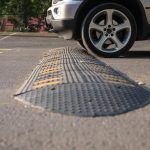The Different Colors of Speed Bumps and Their Meanings
Introduction
Speed bumps are an essential part of road safety measures that are designed to slow down drivers and prevent accidents. They are commonly found in residential areas, school zones, and parking lots. Speed bumps come in different shapes, sizes, and colors, each with its own specific purpose. In this article, we will explore the different colors of speed bumps and their meanings. Understanding the significance of each color can help drivers navigate the roads more safely and effectively.
Yellow Speed Bumps
Yellow speed bumps are typically used in areas where drivers need to slow down significantly, such as near schools or pedestrian crossings. These bumps are often larger and more noticeable than traditional speed bumps, and their bright color helps to draw attention to them. In addition to their use in high-traffic areas, yellow speed bumps are also commonly used in parking lots and other private areas to help control speed and prevent accidents. Overall, the use of yellow speed bumps is an effective way to promote safety and reduce the risk of accidents in a variety of settings.
Red Speed Bumps
Red speed bumps are often used to indicate a high-risk area where drivers need to slow down significantly. These speed bumps are typically found in school zones, hospital areas, and other locations where pedestrian safety is a top priority. The bright red color is meant to catch the attention of drivers and alert them to the need to slow down and pay attention to their surroundings. In some cases, red speed bumps may also be used to indicate a particularly dangerous section of road, such as a sharp turn or blind curve. Overall, red speed bumps are an important tool for promoting safety on the road and reducing the risk of accidents.
Green Speed Bumps
Green speed bumps are often used in areas where there is a need to slow down traffic, but where the visual impact of traditional speed bumps may be undesirable. These speed bumps are typically made from recycled materials and are designed to blend in with the surrounding environment. They are commonly used in parks, residential areas, and other locations where aesthetics are important. Green speed bumps are also often used in areas where there is a need to slow down traffic without causing damage to vehicles, such as in parking lots or on private roads. Overall, green speed bumps are an effective way to slow down traffic while maintaining the visual appeal of the surrounding area.
Blue Speed Bumps
Blue speed bumps are not commonly seen on roads and highways. However, they are often used in parking lots and private roads to indicate that the area is designated for handicap parking. Blue speed bumps are also used in areas where emergency vehicles need to slow down, such as near hospitals or fire stations. The blue color is easily recognizable and helps to differentiate these speed bumps from others on the road. It is important for drivers to be aware of the meaning behind blue speed bumps and to slow down accordingly in these designated areas.
Conclusion
In conclusion, speed bumps are an effective traffic calming measure that can help reduce the speed of vehicles in certain areas. The different colors of speed bumps serve different purposes and convey different messages to drivers. Yellow speed bumps are the most common and indicate a general warning to slow down. Red speed bumps are used in areas where drivers need to come to a complete stop, such as at intersections or pedestrian crossings. Green speed bumps are used in areas where drivers need to be cautious, such as near schools or playgrounds. By understanding the meanings behind the different colors of speed bumps, drivers can better navigate the roads and ensure the safety of themselves and others.






